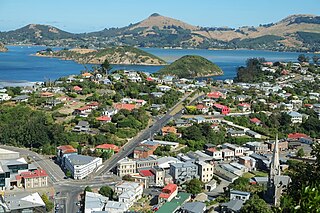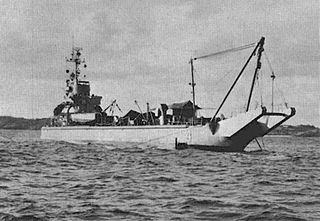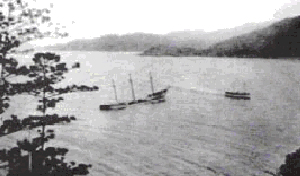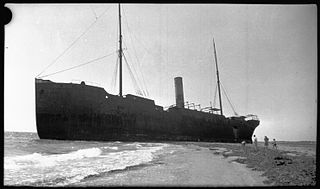
Port Chalmers is a town serving as the main port of the city of Dunedin, New Zealand. Port Chalmers lies ten kilometres inside Otago Harbour, some 15 kilometres northeast of Dunedin's city centre.

A salvage tug, known also historically as a wrecking tug, is a specialized type of tugboat that is used to rescue ships that are in distress or in danger of sinking, or to salvage ships that have already sunk or run aground.

Marine salvage is the process of recovering a ship and its cargo after a shipwreck or other maritime casualty. Salvage may encompass towing, lifting a vessel, or effecting repairs to a ship. Protecting the coastal environment from oil spillages or other contaminants from a modern ship can also be a motivator, as oil, cargo, and other pollutants can easily leak from a wreck.

Moeraki is a small fishing village on the east coast of the South Island of New Zealand. It was once the location of a whaling station. In the 1870s, local interests believed it could become the main port for the north Otago area and a railway line, the Moeraki Branch, was built to the settlement and opened in 1877. However, the port could not compete with Oamaru and the lack of traffic as well as stability problems caused by difficult terrain led to the closure of the railway in 1879 after only two years' operation.

USS Windlass, a Gypsy-class salvage lifting vessel of the United States Navy, was originally conceived as LSM-552 and laid down on 27 August 1945 at Houston, Texas, by Brown Shipbuilding Corporation. Launched on 7 December 1945; and commissioned on 9 April 1946 in Houston at the Tennessee Coal and Iron Docks.
The Aeolian Sky was a Greek-run freighter built in 1978, which collided with another ship near the Channel Islands and after a failed attempt at salvage sank off the coast of Dorset, England in a storm in late 1979.

Pasha Bulker, later known as MV Drake and now MV Anthea, is a Panamax bulk carrier of 76,741 tonnes deadweight (DWT) operated by the Lauritzen Bulkers shipping company and owned by Japanese Disponent Owners. While waiting in the open ocean outside Newcastle harbour to load coal, Pasha Bulker ran aground during a major storm on 8 June 2007 on Nobbys Beach, New South Wales, Australia. It was refloated and moved to a safe location offshore on 2 July 2007 before being towed to Japan for major repairs on 26 July 2007.

The Kātiki Point Lighthouse, also known as Moeraki Lighthouse, shone for the first time in 1878, following several accidents on the dangerous reefs around the area, to make the area safer for ships that sailed past on their way to Port Chalmers, Dunedin. The lighthouse was built between the settlements of Moeraki and Kātiki, on the tip of the Moeraki Peninsula, which is known as Kātiki Point or Moeraki Point.

USNS Sioux (T-ATF-171) was a United States Navy Powhatan-class tugboat operated by the Military Sealift Command (MSC). She was in service from 1981 to 2021 and spent the bulk of this time supporting the Pacific Fleet.

The Moltke was a three-masted barque built in Hamburg, Germany in 1870. The vessel was wrecked off the coast of northern Queensland, Australia in 1890 before being refloated and hulked. In 1911 the vessel was scuttled off Geoffrey Bay, Magnetic Island. The wreck of the vessel now hosts a wide range of underwater life and is a popular open-water dive site.
MT Phoenix was a tanker which went aground in heavy seas at Sheffield Beach just north of Ballito near Durban, South Africa on the morning of 26 July 2011. The vessel was on its way to India to be scrapped when it ran aground. After three attempts, it was refloated, towed and then scuttled and sunk in 2,000 metres (6,600 ft) of water, about 80 kilometres (43 nmi) offshore of Amanzimtoti, south of Durban. The vessel was reportedly owned by either Suhair Khan of Dubai or Marika Investments, Lagos, Nigeria.
The Philip Laing was a 19th-century sailing ship best known as the second immigrant ship to arrive in Dunedin, New Zealand, on 15 April 1848. Chartered by the New Zealand Company for this voyage the ship was carrying Scottish settlers, under the charge of the Rev. Dr. Thomas Burns.

MV Canadian Miner was a Canadian laker that was part of the fleet of Upper Lakes Shipping from 1994–2011. Initially constructed as Maplecliffe Hall in 1966, the ship was renamed Lemoyne in 1988 before becoming Canadian Miner in 1994. In 2011, the name was shortened to just Miner. In 2011 the vessel was taken out of service and sold for scrapping. While en route to the scrapyard in Turkey, the ship ran aground off Nova Scotia in 2011. The vessel was broken up in 2014 in Nova Scotia.

Geffrard was a 321-ton British brig that traded between Australia, Mauritius, and Shanghai, and was wrecked off the coast of Western Australia on 13 June 1875. She was built in 1853 by Fred Clark in Jersey in the Channel Islands. By 1873 she had made her way to Melbourne and was owned by Fred Davis and under the control of Captain William James Munday. Her movements after that were generally around the southern coasts of Australia, from Geraldton in the west to Sydney in the east, laden with a variety of general cargo.

The Nimbin was a steel screw steamer built in 1927 at Copenhagen, that was the first motor vessel placed into the New South Wales coastal trade. It was owned and operated by the North Coast Steam Navigation Company and was the first Australian registered merchant ship to be lost during World War II when it struck a mine laid by the German auxiliary cruiser Pinguin. The Nimbin was on its way from Coffs Harbour to its home port, Sydney, with a cargo of bundled three-ply timber and a cargo of pigs. One third of the ship was blown away and it sank in three minutes. Seven men were killed. The remaining thirteen clung to bundles of plywood. Some hours later an air force plane from RAAF Base Rathmines saw the survivors and directed the coastal ship SS Bonalbo to the scene to retrieve them.

SS Kwinana was an Australian ocean-going cargo and passenger steamship. She was built in England in 1892 as the cargo ship SS Darius. In 1912 she changed owners, was refitted as a cargo and passenger ship and renamed Kwinana.
The City of Dunedin was a 327-ton side wheel paddle steamer wrecked in Cook Strait near Cape Terawhiti on 20 May 1865 while sailing from Wellington to Hokitika via Nelson with the loss of all on board. Captain James Parker Boyd commanded her.













